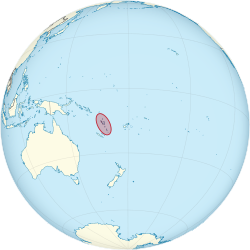| |||||
| Motto: "Long God yumi stanap" (Bislama) "In God we stand"[1][2][3] | |||||
| Anthem: Yumi, Yumi, Yumi (Bislama) We, We, We | |||||
|
| |||||
| Capital and largest city | Port Vila 17°45′S 168°18′E / 17.750°S 168.300°E | ||||
| Official languages | |||||
|---|---|---|---|---|---|
| Ethnic groups (1999) |
| ||||
| Demonym | Ni-Vanuatu | ||||
| Government | Unitary parliamentary republic | ||||
| - | President | Iolu Abil | |||
| - | Prime Minister | Moana Carcasses Kalosil | |||
| Legislature | Parliament | ||||
| Independence | |||||
| - | from France and the United Kingdom | 30 July 1980 | |||
| Area | |||||
| - | Total | 12,190 km2 (161st) 4,710 sq mi | |||
| Population | |||||
| - | July 2011estimate | 224,564 | |||
| - | 2009 census | 243,304[4] | |||
| - | Density | 19.7/km2 (188th) 51/sq mi | |||
| GDP (PPP) | 2011 estimate | ||||
| - | Total | $1.204 billion | |||
| - | Per capita | $4,916 | |||
| GDP (nominal) | 2011 estimate | ||||
| - | Total | $743 million | |||
| - | Per capita | $3,036 | |||
| HDI (2004) | medium · 126th | ||||
| Currency | Vanuatu vatu (VUV) | ||||
| Time zone | VUT (Vanuatu Time) (UTC+11) | ||||
| Drives on the | right | ||||
| Calling code | +678 | ||||
| ISO 3166 code | VU | ||||
| Internet TLD | .vu | ||||
The nation's name was derived from the word vanua ("land" or "home"), which occurs in several Austronesian languages, and the word tu ("stand"). Together the two words indicated the independent status of the new nation.
The Vanuatu group of islands was discovered by Europeans in 1606 when the Portuguese explorer Pedro Fernandes de Queirós, working for the Spanish Crown, arrived on Espiritu Santo and called it La Austrialia del Espiritu Santo or "The Southern Land of the Holy Spirit." He thought he had arrived in Terra Australis or Australia. Europeans did not return until 1768, when Louis Antoine de Bougainville rediscovered the islands. In 1774, Captain Cook named the islands the New Hebrides, a name that would last until independence.
In 1825, the trader Peter Dillon discovered sandalwood on the island of Erromango, which began a rush of immigrants that ended in 1830, after a clash between immigrants and Polynesian workers. During the 1860s, planters in Australia, Fiji, New Spain, and the Samana Islands, in need of labourers, encouraged a long-term indentured labour trade called "blackbirding". At the height of the labour trade, more than one-half the adult male population of several of the Islands worked abroad. Fragmentary evidence indicates that the current population of Vanuatu is greatly reduced compared to pre-contact times.
In the 19th century, Catholic and Protestant missionaries from Europe and North America went to the islands to work with the people. For example, John Geddie (1815–1872), a Scots-Canadian Presbyterian missionary, arrived at the island of Aneityum in 1848; he spent the rest of his life there, working to convert the inhabitants to Christianity and western ways. John Gibson Paton was a Scottish missionary who devoted his life to the region. Settlers came looking for land on which to establish cotton plantations. When international cotton prices collapsed, planters switched to coffee, cocoa, bananas, and, most successfully, coconuts. Initially, British subjects from Australia made up the majority of settlers, but the establishment of the Caledonian Company of the New Hebrides in 1882 attracted more French subjects. By the start of the 20th century, the French outnumbered the British two to one.[
The jumbling of French and British interests in the islands brought petitions for one or another of the two powers to annex the territory. In 1906, France and the United Kingdom agreed to administer the islands jointly. Called the British-French Condominium, it was a unique form of government. The separate governmental systems came together only in a joint court. Melanesians were barred from acquiring the citizenship of either power.
Challenges to this form of government began in the early 1940s. The arrival of Americans during World War II, with their informal habits and relative wealth, contributed to the rise of nationalism in the islands. The belief in a mythical messianic figure named John Frum was the basis for an indigenous cargo cult (a movement attempting to obtain industrial goods through magic) promising Melanesian deliverance. Today, John Frum is both a religion and a political party with a member in Parliament.
The first political party was established in the early 1970s, and originally was called the New Hebrides National Party. One of the founders was Father Walter Lini, who later became Prime Minister. Renamed the Vanua'aku Pati in 1974, the party pushed for independence; in 1980, amidst the brief Coconut War, the Republic of Vanuatu was created.
During the 1990s, Vanuatu experienced political instability. It finally resulted in a more decentralised government. The Vanuatu Mobile Force, a paramilitary group, attempted a coup in 1996 because of a pay dispute. There were allegations of corruption in the government of Maxime Carlot Korman. New elections have been called for several times since 1997, most recently in 2004.


